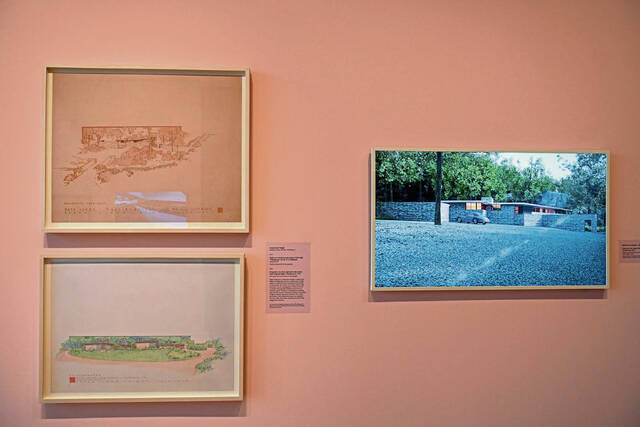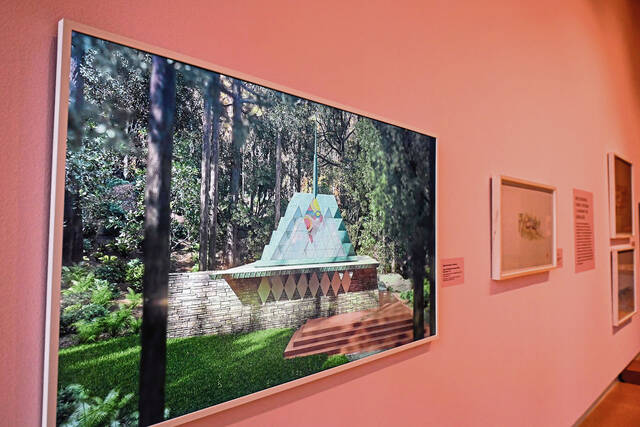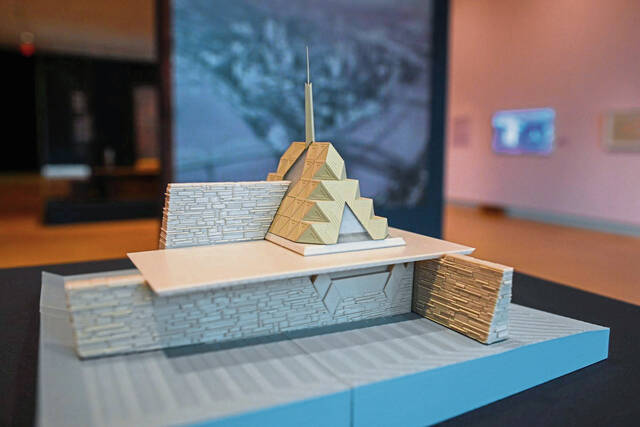What could have been: Westmoreland Museum exhibit brings unrealized Frank Lloyd Wright projects to life
The Laurel Highlands are among few places lucky to be home to several architectural works designed by Frank Lloyd Wright.
Tens of thousands of visitors every year tour Fallingwater, the home he designed for Liliane and Edgar Kaufmann in Mill Run, Fayette County. In Westmoreland County, people can explore Polymath Park’s examples of Wright and Wright-inspired designs.
A new exhibit at The Westmoreland Museum of American Art in Greensburg promises to add depth to Wright’s legacy by showcasing some of the architect’s unfinished and unbuilt residential, commercial and civic projects through video animations and 3D models.
The Westmoreland worked together with Fallingwater to present “Frank Lloyd Wright’s Southwestern Pennsylvania,” on exhibit through Jan. 14.
It includes five unrealized Wright projects for Southwestern Pennsylvania, including his reimagining of the Point in Pittsburgh, a self-service garage for Kaufmann’s Department Store, the Point View Residences designed for the Edgar J. Kaufmann Charitable Trust, the Rhododendron Chapel and a gate lodge for the Fallingwater grounds.
Other unrealized projects are represented in drawings at the exhibit.
“I think that for people who come into the exhibition with a knowledge of Frank Lloyd Wright, they’ll see something completely new, because they’ve only known of these projects as ideas,” said Jeremiah William McCarthy, chief curator. “For people who are unfamiliar with Frank Lloyd Wright, this will be their first introduction to his world.”
Bringing ideas to life
Through 3D-printed models, animations from Oklahoma City-based Skyline Ink Animators + Illustrators, and historical and reproduction drawings and items, the exhibit tells the story of what could have been built in Western Pennsylvania through the eyes of Wright.
The physical and digital representations of what the plans would have looked like will help make architecture real for visitors, McCarthy said.
“To have these animations that show you what would a structure look like that has space for parking for every car in Pittsburgh? What would a civic center with a planetarium and a zoo and shops and a circular football field and all these wonderful things, what would that look like? For good or bad, how would that change Pittsburgh? How would that have changed the Point?” he said.
“I think that this was a way of providing sort of a window into the mind of an architect and showing you something new about one of the most famous architects of the 20th century.”
Scott Perkins, Fallingwater senior director of preservation and collections, said the two museums were interested in exploring the potential influence and legacy the structures would have had if they were built.
“We were sort of thinking, if they had built these — the civic center, the garage, the apartment tower on Mt. Washington — what impact would that have left on the city?” he said. “Would people have been inspired to do similar things? Would they have been completely out of fashion in 20 years? We felt it was important to take them beyond the drafting table. Animation seemed to be the most impactful and easiest way to do that.”
Perkins noted the two centers had originally hoped to present the exhibit in 2021 to reflect a 1946 Kaufman’s pamphlet titled “Pittsburgh in Progress,” which looked ahead to the city 75 years in the future.
The pandemic pushed the date forward, but the ideas behind the exhibit remain. An exhibit focusing on the unbuilt works Wright designed specifically for Fallingwater will be on view there until the end of December.
“We wanted to kind of show what Pittsburgh was envisioned to be in the 1940s, when the Allegheny Conference was being formed and lots of these other civic organizations,” Perkins said. “We worked together with the Westmoreland Museum on an exhibition that could talk about the past and the present but could incorporate this visual technology to talk about the future.”
Dialogue and partnership
An additional complementary exhibit, “Toshiko Mori & Frank Lloyd Wright: Dialogue in Details,” will be on display in the Westmoreland’s Paneled Rooms for the same period as the main exhibit. It highlights the dialogue between two architectural works, Wright’s 1907 Martin House and Mori’s 2009 Eleanor and Wilson Greatbatch Pavilion.
Silvia Filippini-Fantoni, the Westmoreland’s new CEO and director, says the complementary exhibition, alongside the partnership with Fallingwater, highlights an idea of dialogue that drives her.
While she was not the originator of the exhibit — the idea came from discussions between Fallingwater’s leadership and former Westmoreland Museum director Anne Kraybill four years ago — she thinks it’s “a great example” of how she enjoys working with communities and other organizations.
“I think it really exemplifies a lot of the things that I believe in, including partnering with other organizations and bringing our audiences to them,” she said. “It’s a dialogue between our two organizations, and it’s an incredible dialogue between our building and the exhibition.”
Filippini-Fantoni is encouraged by the combination of art and technology that makes the exhibit possible.
“I think that’s the best way you can use technology in museums,” she said. “It’s really bringing the vision of the artist, or in this case the architect, to life. All the level of research that was put into it was incredible.”
General admission to the Westmoreland, 221 N. Main St., is free with advance online registration recommended. The museum’s operating hours are 10 a.m. to 5 p.m. Wednesday through Sunday.
Julia Maruca is a TribLive reporter covering health and the Greensburg and Hempfield areas. She joined the Trib in 2022 after working at the Butler Eagle covering southwestern Butler County. She can be reached at jmaruca@triblive.com.
Remove the ads from your TribLIVE reading experience but still support the journalists who create the content with TribLIVE Ad-Free.




